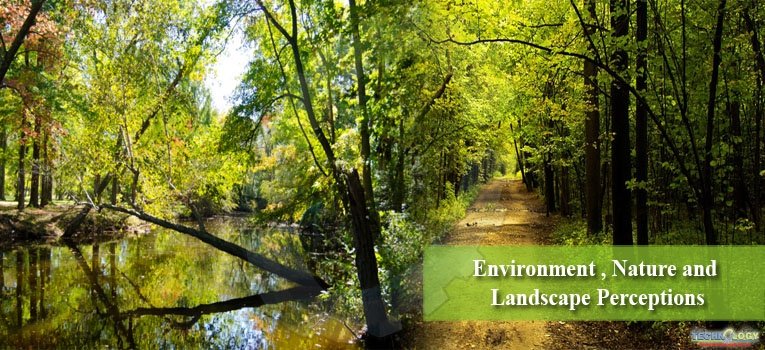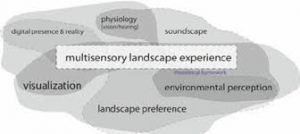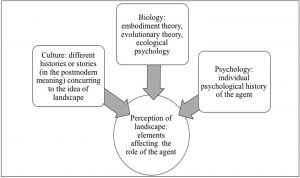The environment would seem to be much under determined by stimulus input. Take the case of continuity of visual experience.

We experience the environment in a continuous, ongoing manner, the stimulus input is typically assumed to be temporally discrete, providing information about what can be seen with a succession of eye fixations.
Psychological processes tend to be conceptualized as distinct and compartmentalized. Hence, perception is considered to be one process, touching another process, moving yet another process, and so on tradition long called ‘faculty psychology’ which still holds psychology in its grip (Uttal, 2001)
Accordingly, much of perception research since the 1950s has involved trying to unravel the causal chain from optical stimulation to brain processes resulting in our mental experience of the world.
(Wohlwill, 1968) research programme rested on the assumption that environment could be characterized as possessing varying degrees of arousal-producing stimulus properties, such as degree of complexity and harmony/disharmony among its features.
On the other hand (Kaplan, 1982) considers the relationship between; on the one hand, the composition of an environmental scene conceptualized as a two-dimensional image or picture.
So from such theories environmental perception might broadly constrain research in landscape perception, and in turn, overlook some essential properties of environments from the point of view of an active perceive.

The perceiver is stationary, temporarily positioned like a camera at a fixed observation point. From this perspective, the perceiver is ‘at a remove’ from the perceived, adopting the stance of a detached spectator rather than that of an engaged agent (Dewey, 1948).

We face with a fragile relation between build and non-build areas, where the relationship of urban– rural space is leading to new relationships in rural areas under urban pressure (Antrop, 2008). Our lives are becoming increasingly controlled by technology, so the direct connection to nature is disappearing into the background of everyday life. The smartest way is to take advantage of nature, learning from it.
Our imagination is strongly molded by countless shapes and natural structures that reflect both the building structure and the spatial development approach. This way of working can then be closely linked into the ecosystemic processes which underlie any sustainable design endeavor that aims to harmonies with nature (Stevenson, 2006).
Similarities between building structure and plants, how to copy nature for decoration reasons, solving the discharges considering how they are building trees, the plants, the animals were beginning of this approach.
Now we are facing with a much deeper discourse, thus, to study the existence of biological systems can develop new concepts for sustainable buildings as well as for city and landscape planning (Benko, 2010), but these ideas are still in a growing field.
Examples of biological systems exist as metaphor of space for new sustainable concepts from the building to the territory and identify the biosphere limits through can still sustain the growth and development conventional from now to the future.
Over time, appeared two positions of the nature-culture relationship in human perception, and these relationships are based on a different approach to the environment. There are alternative models resulting from the adoption of circular economic and educational systems (Cohen, 2005).
This game of relationships nature/culture perception continuously produce a new structure of build environment, expressed through the landscape as an expression of new economic structures (characteristics of built space, ratio of agriculture/ industry / services, in which the last become dominant – travel, insurance, banking, specialized education, cultural services.
Influences and changes are not limited to endogenous relations, are also present in relation to the territory with differences between regions sensitive to different territorial scales, landscape and infrastructure.
In this relationship could occur dynamics under urbanization pressure on the land for housing, transport infrastructure, economic and tourist activities (Antrop, 2004). Ideally, land use planning could act as a tool to deal with the various, often conflicting, demands from human experience in territorial space.
A significant educational and practical instruments that have transformed the ways in which we conceive and configure space means design and simulation of different development and evolution scenarios have enabled the emergence of new landscapes environmental parameters that are changing the ways in which we include disparate information within design process, but are also significantly altering the methodological approach.
The first generation of specialists (architects, environmentalists, planners, landscapers) came, with few exceptions, to the view that nature must be protected from destructive result of building, and chaotic growing development.
In its extreme form, this point of view means: nature, anything that is not done or not touched by human hands and culture is everything which is touched by human hand and are seen as two separate, exclusive systems: nature cannot be where the culture is.
In this perception, the approach of human intervention is a losing battle in front of nature. We may be able to slow or take care of this process, but we will never stop it. In the best case we give in to nature. One view that it needs to reduce consumption and ultimately savings prosperity.
How noble and ethical is an issue to think on it. This vision hasn’t produced so intelligent solutions for environmental and clime problems, but is an open discussion.

Nature and culture cannot be considered similar systems. Besides mountainous stretches, desert and tropical forests everywhere on the solid ground of the planet we find this blend of natural and artificial. Considering the nature and culture as mutually exclusive systems, in a sustainable environmental culture.
Human intervention in the landscape construction can be considered as real as nature and the natural environment in a more aggressive approach. a concept that balances between the physical, aesthetic and social space, which is defined as a designed space, lived space, perceived space (Lefebvre, 1947).
After Lefebvre, the designed space is based on a series of representations of the space and conventions (scientists and planners). The landscape is a place of conflict, the place of a perpetual compromise (Jackson 1984), which we can consider as a sum of these three spaces.
It is designed because it started from the structure of the collective identity. It is also perceived, over the customary practices (and through its vernacularism) and it is experienced as it is symbolized; it bears within itself the daily and power signs.
Thus, Environment and landscape development are closely linked; the second one may be positive or negative consequences in relation to recovery and management activities.
Management and sustainability of landscape in territory require to understand the impact of external environmental effects and to control socioeconomic, development and use of media and also to maintain the quality indicators of landscape resources and spatial development markets.